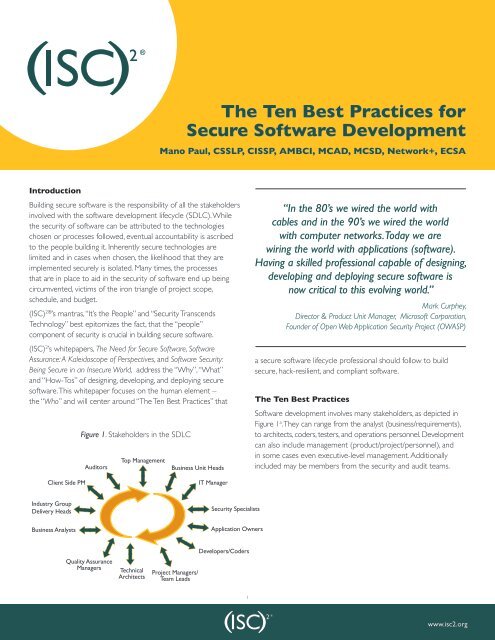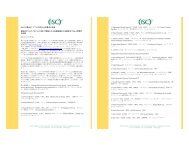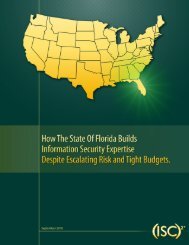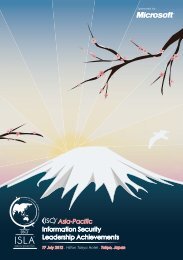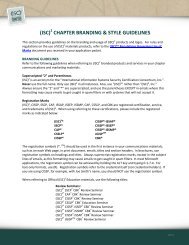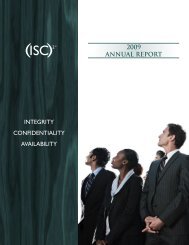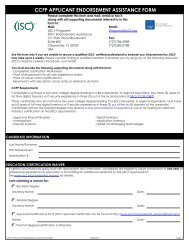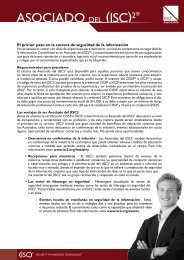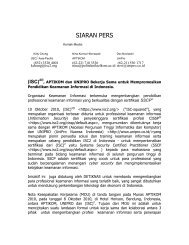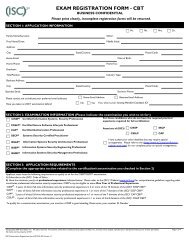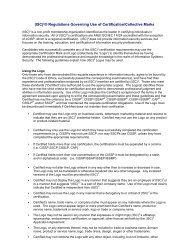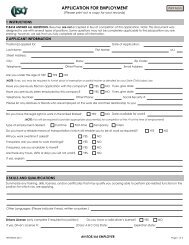The Ten Best Practices for Secure Software Development - ISC
The Ten Best Practices for Secure Software Development - ISC
The Ten Best Practices for Secure Software Development - ISC
You also want an ePaper? Increase the reach of your titles
YUMPU automatically turns print PDFs into web optimized ePapers that Google loves.
Introduction<br />
Building secure software is the responsibility of all the stakeholders<br />
involved with the software development lifecycle (SDLC). While<br />
the security of software can be attributed to the technologies<br />
chosen or processes followed, eventual accountability is ascribed<br />
to the people building it. Inherently secure technologies are<br />
limited and in cases when chosen, the likelihood that they are<br />
implemented securely is isolated. Many times, the processes<br />
that are in place to aid in the security of software end up being<br />
circumvented, victims of the iron triangle of project scope,<br />
schedule, and budget.<br />
(<strong>ISC</strong>) 2® ’s mantras, “It’s the People” and “Security Transcends<br />
Technology” best epitomizes the fact, that the “people”<br />
component of security is crucial in building secure software.<br />
(<strong>ISC</strong>) 2 ’s whitepapers, <strong>The</strong> Need <strong>for</strong> <strong>Secure</strong> <strong>Software</strong>, <strong>Software</strong><br />
Assurance: A Kaleidoscope of Perspectives, and <strong>Software</strong> Security:<br />
Being <strong>Secure</strong> in an Insecure World, address the “Why”, “What”<br />
and “How-Tos” of designing, developing, and deploying secure<br />
software. This whitepaper focuses on the human element –<br />
the “Who” and will center around “<strong>The</strong> <strong>Ten</strong> <strong>Best</strong> <strong>Practices</strong>” that<br />
Client Side PM<br />
Industry Group<br />
Delivery Heads<br />
Business Analysts<br />
Figure 1. Stakeholders in the SDLC<br />
Auditors<br />
Quality Assurance<br />
Managers<br />
Top Management<br />
Technical<br />
Architects<br />
<strong>The</strong> <strong>Ten</strong> <strong>Best</strong> <strong>Practices</strong> <strong>for</strong><br />
<strong>Secure</strong> <strong>Software</strong> <strong>Development</strong><br />
Mano Paul, CSSLP, CISSP, AMBCI, MCAD, MCSD, Network+, ECSA<br />
Business Unit Heads<br />
Project Managers/<br />
Team Leads<br />
IT Manager<br />
Security Specialists<br />
Application Owners<br />
Developers/Coders<br />
1<br />
“In the 80’s we wired the world with<br />
cables and in the 90’s we wired the world<br />
with computer networks. Today we are<br />
wiring the world with applications (software).<br />
Having a skilled professional capable of designing,<br />
developing and deploying secure software is<br />
now critical to this evolving world.”<br />
Mark Curphey,<br />
Director & Product Unit Manager, Microsoft Corporation,<br />
Founder of Open Web Application Security Project (OWASP)<br />
a secure software lifecycle professional should follow to build<br />
secure, hack-resilient, and compliant software.<br />
<strong>The</strong> <strong>Ten</strong> <strong>Best</strong> <strong>Practices</strong><br />
<strong>Software</strong> development involves many stakeholders, as depicted in<br />
Figure 1 a . <strong>The</strong>y can range from the analyst (business/requirements),<br />
to architects, coders, testers, and operations personnel. <strong>Development</strong><br />
can also include management (product/project/personnel), and<br />
in some cases even executive-level management. Additionally<br />
included may be members from the security and audit teams.<br />
Requirements<br />
www.isc2.org<br />
24<br />
hours
A secure software lifecycle professional (SSLP) is any stakeholder<br />
who is responsible <strong>for</strong> building software with the goal of ensuring<br />
that the software built is not susceptible to security breaches.<br />
It must be understood that no software is 100% secure. However,<br />
software can be designed, developed, and deployed with a secure<br />
mindset, factoring in necessary security controls that minimize the<br />
likelihood of exposure and the impact if exploited. <strong>The</strong> following<br />
practices can help fulfill the SSLP’s mission of building hackresilient<br />
software.<br />
<strong>The</strong> <strong>Ten</strong> <strong>Best</strong> <strong>Practices</strong><br />
1. Protect the Brand Your Customers Trust<br />
2. Know Your Business and Support it with<br />
<strong>Secure</strong> Solutions<br />
3. Understand the Technology of the<br />
<strong>Software</strong><br />
4. Ensure Compliance to Governance,<br />
Regulations, and Privacy<br />
5. Know the Basic <strong>Ten</strong>ets of <strong>Software</strong><br />
Security<br />
6. Ensure the Protection of Sensitive<br />
In<strong>for</strong>mation<br />
7. Design <strong>Software</strong> with <strong>Secure</strong> Features<br />
8. Develop <strong>Software</strong> with <strong>Secure</strong> Features<br />
9. Deploy <strong>Software</strong> with <strong>Secure</strong> Features<br />
10. Educate Yourself and Others on How to<br />
Build <strong>Secure</strong> <strong>Software</strong><br />
<strong>Best</strong> Practice #1: Protect the Brand Your<br />
Customers Trust<br />
<strong>The</strong> Harvard Business Review special publication, “Breakthrough<br />
Ideas <strong>for</strong> 2008,” b listed “Cybercrime Service Economy” as one<br />
of the top 20 trans<strong>for</strong>mations of the business world. Scott<br />
Berinato, Executive editor of CSO magazine, who contributed to<br />
the publication, asserts that the new breed of hackers don’t just<br />
cause interruptions to a business, but threaten it by undermining<br />
commercial confidence and customer trust. His conclusion is<br />
noteworthy; in the event of cybercrimes, victims will look <strong>for</strong><br />
someone to be held responsible, and it will not be the hackers<br />
but the brands that the victims trusted to protect them.<br />
2<br />
Security is a never-ending challenge. As the cybercriminals evolve,<br />
so must the defenders. It’s the defenders and their organizations<br />
that need to stay a step ahead of cybercriminals or else they will<br />
be held responsible <strong>for</strong> security breaches. Breaches leading to<br />
critical situations such as disclosure of customer in<strong>for</strong>mation, denial<br />
of service, and threats to the continuity of business operations<br />
can have dire financial consequences. Yet the real cost to the<br />
organization will be the loss of customer trust and confidence in the<br />
organization’s brand. Such a loss may be irreparable and impossible<br />
to quantify in mere monetary terms. Etched in the <strong>for</strong>efront of<br />
the mind of any SSLP must be the need to protect the brand,<br />
customers trust. Fundamentally, the recognition that the organization<br />
is obligated to protect the customers should powerfully motivate<br />
the organization in creating more secure software.<br />
As a SSLP, you must protect the brand your customers trust.<br />
<strong>Best</strong> Practice #2: Know Your Business and Support<br />
it with <strong>Secure</strong> Solutions<br />
Most skilled security professionals agree that, along with a strong<br />
background in technology, a thorough understanding of the<br />
business is of paramount importance when it comes to creating<br />
secure solutions <strong>for</strong> that business. Though some purist security<br />
technologists may find it difficult to accept, it is nevertheless<br />
true that security is there <strong>for</strong> the business and not the other<br />
way around. Security exists to enable the business, not to be<br />
an impediment. <strong>The</strong> answer to the question, “Why were brakes<br />
invented?” could be answered in two ways: to prevent the vehicle<br />
from an accident, or to allow the vehicle to go faster. Security<br />
is similar; it can prevent the business from a crash, or allow the<br />
business to go faster.<br />
For a SSLP, understanding the business can help in the<br />
identification of regulatory and compliance requirements,<br />
applicable risk, architectures to be used, technical controls to<br />
be incorporated, and the users to be trained or educated. For<br />
example, an internet banking organization will need to deal with<br />
regulatory requirements such as financial privacy, safeguards, and<br />
pretexting rules c as part of its compliance with the Gramm Leach<br />
Bliley Act (GLBA). <strong>The</strong> organization will have to address the risk of<br />
disclosure of personally identifiable and financial in<strong>for</strong>mation, the<br />
need to have multi-factor authentication architecture, encryption,<br />
authentication, authorization, and auditing controls, as well as the<br />
need to educate employees on social engineering and phishing.<br />
A retail merchant may need to comply with the Payment Card<br />
Industry Data Security Standard (PCI DSS) depending on how<br />
they handle credit card transactions.<br />
As a SSLP, you must know your business and support it with<br />
secure solutions.<br />
www.isc2.org
<strong>Best</strong> Practice #3: Understand the Technology<br />
of the <strong>Software</strong><br />
Not only is it critical to know the business, but one must have<br />
a strong background in technology to be effective in building<br />
or buying secure software. A lack of understanding of the<br />
technology used to build or buy software can lead to insecure<br />
implementations of the software.<br />
When it comes to building the software in-house, a thorough<br />
understanding of the existing infrastructural components, such as<br />
network segregation, hardened hosts, and public key infrastructure,<br />
is necessary to ensure that the deployment of the software will,<br />
first, be operationally functional and, second, not weaken the<br />
security of the existing environment. In other words, understanding<br />
the interplay of your current technological components with the<br />
software you build and/or deploy will help determine the impact<br />
on overall security. Further, understanding the technology used in<br />
building software can help towards making decisions that favor<br />
security. As an example, knowing that managed code (.Net and<br />
Java) have less likelihood of memory corruption and thus are less<br />
susceptible to overflow attacks than unmanaged code (C/C++),<br />
would help in choosing newer-generation managed code as part<br />
of the coding standard to develop software.<br />
With software procurement, it is vital to recognize that vendor<br />
claims regarding the ‘security’ features need to be scrutinized and<br />
verified <strong>for</strong> implementation feasibility within your organization.<br />
<strong>The</strong> mere presence of security features in a product does not<br />
necessarily mean that the product is secure. <strong>The</strong> appropriate<br />
and correct implementation of the security features is what<br />
helps make a product secure.<br />
As a SSLP, it’s critical to understand the technology of the software.<br />
<strong>Best</strong> Practice #4: Ensure Compliance to<br />
Governance, Regulations, and Privacy<br />
In this day and age, an industry that is not regulated is more the<br />
exception than the norm as opposed to just a few years ago<br />
when the industry that was regulated was the exception.<br />
<strong>The</strong> increase in regulatory and privacy requirements imposes<br />
a serious burden on organizations. Governance, Risk, and<br />
Compliance (GRC) is not just an industry buzz phrase, but a<br />
reality and a means toward meeting regulatory and privacy<br />
requirements. As a SSLP, one must understand the internal<br />
and external policies that govern the business, its mapping<br />
to necessary security controls, the residual risk from post<br />
implementation of security controls in the software, and the<br />
evergreen aspects of compliance to regulations and privacy<br />
requirements.<br />
As a SSLP, you must ensure governance, risk, and compliance<br />
to regulations and privacy.<br />
3<br />
“Compliance is often thought of as a finish<br />
line <strong>for</strong> an organization’s security. That’s the<br />
wrong mindset. Validation to compliance is merely<br />
a snapshot in time illustrating the current state<br />
of security against set criteria. Compliance should<br />
be considered as organic as an organization’s<br />
business model. Even more so as the threat<br />
landscape continually evolves alongside<br />
advancements in technology.”<br />
Troy Leach, CISSP, CISA<br />
Technical Director,<br />
PCI Security Standards Council<br />
<strong>Best</strong> Practice #5: Know the Basic <strong>Ten</strong>ets of<br />
<strong>Software</strong> Security<br />
When it comes to secure software, there are some tenets<br />
with which the SSLP must be familiar. <strong>The</strong>se basic tenets are:<br />
protection from disclosure (confidentiality); protection from<br />
alteration (integrity); protection from destruction (availability);<br />
who is making the request (authentication); what rights and<br />
privileges does the requestor have (authorization); the ability<br />
to build historical evidence (auditing); and the management of<br />
configuration, sessions, and exceptions. Knowledge of these basic<br />
tenets, and how they can be implemented in software, is of vital<br />
importance <strong>for</strong> the SSLP.<br />
Some mechanisms that can be implemented to support these<br />
tenets are described below. Encryption, <strong>for</strong> example, can serve<br />
as a confidentiality control, while hashing can serve as both a<br />
confidentiality control and integrity control. Encryption uses<br />
algorithms to convert humanly-readable in<strong>for</strong>mation (plaintext)<br />
into non-readable cryptic (ciphertext) <strong>for</strong>m. Decryption is<br />
the process of converting the ciphertext back into plaintext.<br />
Encryption and decryption require a key that is held secretly to<br />
per<strong>for</strong>m their operations.<br />
Encryption algorithms can be either symmetric or asymmetric.<br />
Symmetric algorithms use the same key to encrypt and decrypt<br />
and while this may be fast, the number of keys required to manage<br />
communication between parties can become cumbersome very<br />
quickly and make key management a challenge. Asymmetric<br />
algorithms use different keys <strong>for</strong> encryption and decryption, also<br />
known as a public-private key pair. Certificates are used to share<br />
the public key and the existence of a public key infrastructure is<br />
necessary. This is a lot slower than symmetric algorithms but key<br />
distribution and management is simplified.<br />
www.isc2.org
Hashing on the other hand uses mathematical functions that<br />
are one-way. <strong>The</strong> difference between encryption and hashing is<br />
that with encryption, the original value can be re-factored; with<br />
hashing, this is not possible. Any value passed in is rehashed with<br />
the same function and then compared <strong>for</strong> validity. Hashing is more<br />
an integrity measure to detect tampering of data or files, but can<br />
be used <strong>for</strong> protecting sensitive in<strong>for</strong>mation like passwords when<br />
stored and used <strong>for</strong> authentication.<br />
Proper load-balancing and load-monitoring functionality in your<br />
software can protect against destruction or denial of service, and<br />
ensure availability. Password, token, or biometric means to identify<br />
and validate one’s credentials are examples of authentication<br />
mechanisms, while role-based access control that the software<br />
checks is an example of authorization control. <strong>Secure</strong> software<br />
must also log and record all administrative, critical, and key<br />
business transactions so that a historical audit trail can be built<br />
when necessary. Configuration in<strong>for</strong>mation must be treated as<br />
sensitive in<strong>for</strong>mation and protected. Sessions should be unique<br />
to prevent any replay or hijacking attacks, and generic and laconic<br />
exception messages must be explicitly specified to prevent<br />
disclosure of too much in<strong>for</strong>mation.<br />
As a SSLP, it’s critical to know the basic tenets of software security.<br />
Is Publicly<br />
Disclosed?<br />
Is Disclosed<br />
by Roles?<br />
No<br />
No<br />
Is Disclosed<br />
by Restricted<br />
Roles?<br />
Yes<br />
Yes<br />
Yes<br />
4<br />
<strong>Best</strong> Practice #6: Ensure the Protection of<br />
Sensitive In<strong>for</strong>mation<br />
In addition to ensuring that the brand your customers trust is<br />
protected, it is essential that any sensitive in<strong>for</strong>mation be protected<br />
as well. Sensitive in<strong>for</strong>mation refers to any in<strong>for</strong>mation upon which<br />
the organization places a measurable value. By implication, this is<br />
in<strong>for</strong>mation that is not in the public domain and would result in loss,<br />
damage, or even business collapse should the in<strong>for</strong>mation be lost,<br />
stolen, corrupted, or in any way compromised. Sensitive in<strong>for</strong>mation<br />
may be personal, health, financial, or any other in<strong>for</strong>mation that can<br />
affect the competitive edge of your organization.<br />
While it is easy to identify the sensitivity of certain data elements<br />
such as, health records or credit card in<strong>for</strong>mation, other elements<br />
may not be that evident. Determination of what is sensitive<br />
and what is not can be accomplished by undertaking a data<br />
classification exercise, with the business stakeholders involved in<br />
this process. <strong>Software</strong> that either transports, processes, or stores<br />
sensitive in<strong>for</strong>mation must build in necessary security controls to<br />
protect this in<strong>for</strong>mation.<br />
A SSLP must be familiar with data classification and protection<br />
mechanisms against disclosure. Data classification is the conscious<br />
decision to assign a level of sensitivity to data as it is being created,<br />
amended, stored, transmitted, or enhanced. <strong>The</strong> classification of<br />
the data should then determine the extent to which the data<br />
needs to be controlled/secured. Figure 2 depicts an example of<br />
a flowchart that can be used to classify in<strong>for</strong>mation.<br />
As a SSLP, you have to ensure the protection of sensitive in<strong>for</strong>mation.<br />
Minimal/No Yes<br />
Minimal/No Yes<br />
Public Damage on<br />
Low Impact on<br />
Support<br />
Alteration<br />
Destruction<br />
Confidential<br />
Restricted<br />
Figure 2. Example of a data classification flowchart<br />
Significant<br />
Damage on<br />
Alteration<br />
No<br />
No<br />
Critical<br />
Damage on<br />
Alteration<br />
Data<br />
Yes<br />
Yes<br />
Medium<br />
High<br />
Significant<br />
Impact on<br />
Destruction<br />
No<br />
No<br />
Critical<br />
Impact on<br />
Destruction<br />
Confidentiality Integrity Availability<br />
Yes<br />
Yes<br />
Essential<br />
Critical<br />
www.isc2.org
<strong>Best</strong> Practice #7: Design <strong>Software</strong> with<br />
<strong>Secure</strong> Features<br />
<strong>The</strong> MSDN article on “Lessons Learned from Five Years of Building<br />
More <strong>Secure</strong> <strong>Software</strong>,” d under the heading “It’s not just the code,”<br />
highlights that many software security vulnerabilities are not coding<br />
issues at all but design issues. When one is exclusively focused<br />
on finding security issues in code, that person runs the risk of<br />
missing out on entire classes of vulnerabilities. Security issues in<br />
design and semantic flaws (ones that are not syntactic or code<br />
related), such as business logic flaws, cannot be detected in code<br />
and need to be inspected by per<strong>for</strong>ming threat models and abuse<br />
cases modeling during the design stage of the SDLC.<br />
Threat modeling is an iterative-structured technique used<br />
to identify the threats to the software being built. It starts by<br />
identifying the security objectives of the software and profiles it.<br />
It breaks the software into physical and logical constructs<br />
generating the software context that includes data flow diagrams,<br />
and end-to-end deployment scenarios, identifying entry and exit<br />
points, protocols, components, identities, and services.<br />
Attack surface analysis is a subset of threat modeling and can<br />
be per<strong>for</strong>med when generating the software context in which<br />
sections of the software exposed to un-trusted users is analyzed<br />
<strong>for</strong> security issues. Once the software context is generated,<br />
pertinent threats and vulnerabilities can be identified.<br />
Threat Modeling is per<strong>for</strong>med during the design stage so that<br />
necessary security controls (safeguards) can be developed<br />
during the development phase of the software.<br />
5<br />
In addition to understanding how to threat model software,<br />
a SSLP must be aware of how to implement secure design<br />
principles. <strong>The</strong> well-acclaimed paper “<strong>The</strong> Protection of<br />
In<strong>for</strong>mation in Computer Systems” e by Saltzer and Schroeder<br />
lists some very sound design principles, as shown in Table 1.<br />
As a SSLP, you must design software with secure features.<br />
<strong>Best</strong> Practice #8: Develop <strong>Software</strong> with<br />
<strong>Secure</strong> Features<br />
Designing <strong>for</strong> security in software is futile unless you plan to act<br />
on the design and incorporate necessary secure controls during<br />
the development stage of your software development lifecycle.<br />
It is imperative that secure features are not ignored when design<br />
artifacts are converted into syntax constructs that a compiler or<br />
interpreter can understand. Writing secure code is no different<br />
than writing code that is usable, reliable, or scalable.<br />
“Security is just another attribute of software<br />
like usability, per<strong>for</strong>mance, reliability, scalability.<br />
<strong>The</strong> idea of incorporating security into the<br />
SDLC begins with evaluating the relative<br />
importance of this attribute and then going on<br />
to incorporating controls in line with that.”<br />
Table 1. Adapted from the Saltzer & Schroeder Protection of In<strong>for</strong>mation in Computer Systems<br />
Design Principle What is it? Example<br />
Economy of mechanism<br />
Fail-safe defaults<br />
Complete mediation<br />
Open design<br />
Separation of privilege<br />
Least privilege<br />
Least common mechanisms<br />
Psychological acceptability<br />
Keeping the design simple and less complex<br />
Access denied by default and granted explicitly<br />
Checking permission each time subject requests<br />
access to objects<br />
Design is not a secret, implementation of safeguard is<br />
More than one condition is required to complete a task<br />
Rights are minimum and users granted access explicitly<br />
Common mechanisms to more than one user/<br />
process/role is not shared<br />
Security protection mechanism unbeknownst to<br />
the end user <strong>for</strong> ease of use and acceptance<br />
Tallah Mir<br />
Sr. Program Manager<br />
Microsoft<br />
Modular code, Shared objects, and<br />
Centralized services<br />
Denied transaction<br />
Credentials not cached<br />
Cryptographic algorithms<br />
Split keys, Compartmentalized functions<br />
Non-administrative accounts,<br />
Need to know<br />
Role based dynamic libraries and functions<br />
Help dialogs, Visually appealing icons<br />
www.isc2.org
Controls, which address the basic tenets of software security,<br />
must be validated through security code reviews and security<br />
testing. It is recommended that security code review be<br />
per<strong>for</strong>med while the code is reviewed <strong>for</strong> functionality, and be<strong>for</strong>e<br />
the software is released <strong>for</strong> testing. Security code reviews can be<br />
manual or automated. Code review tools are not a panacea and<br />
can assist only to a certain degree to identify sections of code that<br />
need attention. To keep the false positive and false negative rate<br />
to a minimum, tools often miss certain vulnerabilities. <strong>The</strong>re<strong>for</strong>e,<br />
automated code review should never be undertaken in lieu<br />
of human (manual) reviews. Definition of the scope of what is<br />
being reviewed, the extent of the review, coding standards,<br />
secure coding requirements, code review process with roles<br />
and responsibilities, and en<strong>for</strong>cement mechanisms, must be<br />
pre-defined <strong>for</strong> a security code review to be effective.<br />
Security testing should complement existing functionality testing.<br />
At a bare minimum, tests <strong>for</strong> common software vulnerabilities,<br />
such as overflow and injection flaws, and testing the behavior of<br />
software to unexpected and random input <strong>for</strong>mats (fuzz testing)<br />
should be conducted in testing environments that emulate the<br />
configuration of the production environment. Other tests <strong>for</strong><br />
stress and per<strong>for</strong>mance need to be conducted as well, as they<br />
directly relate to the “availability” tenet of security. A SSLP should<br />
not only ensure that the code written is secure, but also know<br />
how to write secure code, conduct, per<strong>for</strong>m, and orchestrate<br />
code reviews and security testing.<br />
As a SSLP, you must develop software with secure features.<br />
<strong>Best</strong> Practice #9: Deploy <strong>Software</strong> with<br />
<strong>Secure</strong> Features<br />
Most software development teams would agree that, often,<br />
software that works without any issues in development and test<br />
environments will start experiencing hiccups when deployed/<br />
released into a more hardened production environment. Post<br />
mortem analyses in a majority of these cases reveal that the<br />
development and test environments do not properly simulate<br />
the production environment. Fundamentally, this is a configuration<br />
management issue. Changes made to the production environment<br />
should be retrofitted to the development and test environments<br />
through proper change management processes.<br />
Another related issue is release management of software which<br />
should include proper source code control and versioning.<br />
A phenomenon that one might refer to as “regenerative bugs” is<br />
often observed when it comes to improper release-management<br />
processes. Regenerative bugs are fixed software defects that<br />
reappear in subsequent releases of the software. This happens<br />
when the software coding defect (bug) is detected in the testing<br />
environment (such as user-acceptance testing) and the fix is made<br />
in that test environment and promoted to production, without<br />
6<br />
retrofitting it into the development environment. <strong>The</strong> latest<br />
version in the development environment does not have the fix<br />
and the issue reappears in subsequent versions of the software.<br />
To deploy secure software, it is also recommended that software<br />
undergo vulnerability assessment and penetration testing in a<br />
pre-production environment and, if need be, in the production<br />
environment with tight control. This will help make evident the<br />
potential issues that may be uncovered by an attacker, and gives<br />
the software development team insight into the weak areas of<br />
the software.<br />
<strong>Secure</strong> deployment ensures that the software is functionally<br />
operational and secure at the same time. It means that software<br />
is deployed with defense-in-depth, and attack surface area is<br />
not increased by improper release, change, or configuration<br />
management. It also means that assessment from an attacker’s<br />
point of view is conducted prior to or immediately upon<br />
deployment. <strong>Secure</strong> design and development of software must<br />
be augmented with secure deployment.<br />
As a SSLP, you must deploy software with secure features.<br />
<strong>Best</strong> Practice #10: Educate Yourself and Others on<br />
How to Build <strong>Secure</strong> <strong>Software</strong><br />
<strong>The</strong> need to design, develop, and deploy more secure software<br />
is evident from the security incidents prevalent in the industry,<br />
and the plethora of regulations and privacy requirements one<br />
needs to comply with. <strong>The</strong> modus operandi of software today is<br />
the infamous release-and-patch cycle.<br />
To combat this vicious cycle of release-and-patch, there is a<br />
need <strong>for</strong> a change – to create a culture that factors in software<br />
security from the very beginning by default. Creating a security<br />
culture can be accomplished through education. <strong>The</strong> National<br />
Institute of Standards and Technology (NIST) states that education<br />
should cause a change in attitudes, which in turn will change<br />
the organizational culture. In essence, this cultural change is the<br />
realization that IT security is critical because a security failure has<br />
potentially adverse consequences <strong>for</strong> everyone and, there<strong>for</strong>e,<br />
IT security is everyone’s job. f Even the most expensive security<br />
measures can be thwarted by people, and educating people about<br />
software security is of paramount importance.<br />
Not only must one be educated, but they must also be willing to<br />
share their knowledge. As Charles Dickens once wrote, “Change<br />
begets change.” When one who is educated in turn educates<br />
others, there will be a compound effect towards creating the<br />
much-needed security culture.<br />
As a SSLP, it’s important to educate yourself and others on how to<br />
build secure software.<br />
www.isc2.org
Conclusion<br />
<strong>The</strong> McKinsey report, “<strong>The</strong> War <strong>for</strong> Talent,” g released in 1998<br />
predicted that the most important corporate resource over the<br />
next 20 years would be talent. It’s been a decade since the report<br />
was published, and when it comes to software security talent, this<br />
prediction could not have been any more accurate. Advancement<br />
in security technologies and improvements in processes, such as<br />
the secure development lifecycle and trustworthy computing,<br />
has accelerated. People without proper knowledge of software<br />
security can circumvent even the most carefully thought-out<br />
security implementations.<br />
<strong>The</strong> importance of educating people and creating a culture that<br />
views software security as second nature is crucial. <strong>The</strong> newest<br />
certification from (<strong>ISC</strong>)² ® , the Certified <strong>Secure</strong> <strong>Software</strong> Lifecycle<br />
Professional (CSSLP CM ), is a step in that direction. Covering areas<br />
that ensure security is considered throughout the entire software<br />
lifecycle, the CSSLP is created around the specific need <strong>for</strong><br />
building security in the software lifecycle.<br />
<strong>Software</strong> development involves various stakeholders. Those tasked<br />
to build software securely must follow certain directives. <strong>The</strong>se<br />
“<strong>Ten</strong> <strong>Best</strong> <strong>Practices</strong> <strong>for</strong> a <strong>Secure</strong> <strong>Software</strong> Lifecycle Professional”<br />
when followed will ensure that the SSLP build secure, hackresilient,<br />
and compliant software.<br />
People without proper knowledge of software<br />
security can circumvent even the most carefully<br />
thought-out security implementations.<br />
About (<strong>ISC</strong>)² ®<br />
<strong>The</strong> International In<strong>for</strong>mation Systems Security Certification<br />
Consortium, Inc. [(<strong>ISC</strong>) 2® ] is the globally recognized Gold Standard<br />
<strong>for</strong> certifying in<strong>for</strong>mation security professionals. Founded in<br />
1989, (<strong>ISC</strong>)² has now certified over 60,000 in<strong>for</strong>mation security<br />
professionals in more than 130 countries. Based in Palm Harbor,<br />
Florida, USA, with offices in Washington, D.C., London, Hong<br />
Kong and Tokyo, (<strong>ISC</strong>) 2 issues the Certified In<strong>for</strong>mation Systems<br />
Security Professional (CISSP ® ) and related concentrations,<br />
Certified <strong>Secure</strong> <strong>Software</strong> Lifecycle Professional (CSSLP CM ),<br />
Certification and Accreditation Professional (CAP ® ), and Systems<br />
Security Certified Practitioner (SSCP ® ) credentials to those<br />
meeting necessary competency requirements. (<strong>ISC</strong>)² CISSP and<br />
related concentrations, CAP, and the SSCP certifications are<br />
among the first in<strong>for</strong>mation technology credentials to meet the<br />
stringent requirements of ANSI/ISO/IEC Standard 17024, a global<br />
benchmark <strong>for</strong> assessing and certifying personnel. (<strong>ISC</strong>)² also<br />
offers a continuing professional education program, a portfolio<br />
of education products and services based upon (<strong>ISC</strong>) 2 ’s CBK ® , a<br />
compendium of in<strong>for</strong>mation security topics, and is responsible <strong>for</strong><br />
the (<strong>ISC</strong>)² Global In<strong>for</strong>mation Security Work<strong>for</strong>ce Study. More<br />
in<strong>for</strong>mation is available at www.isc2.org.<br />
7<br />
About the Author<br />
Mano Paul, CSSLP, CISSP, AMBCI, MCAD, MCSD, Network+,<br />
ECSA is CEO and President of Express Certifications and<br />
SecuRisk Solutions, companies specializing in professional training,<br />
certification, security products and security consulting. His security<br />
experience includes designing and developing software security<br />
programs from Compliance-to-Coding, application security risk<br />
management, security strategy and management, and conducting<br />
security awareness sessions, training, and other educational<br />
activities. He is currently authoring the Official (<strong>ISC</strong>) 2 Guide to<br />
the CSSLP, is a contributing author <strong>for</strong> the In<strong>for</strong>mation Security<br />
Management Handbook, writes periodically <strong>for</strong> Certification,<br />
<strong>Software</strong> <strong>Development</strong> and Security magazines and has<br />
contributed to several security topics <strong>for</strong> the Microsoft Solutions<br />
Developer Network. He has been featured in various domestic<br />
and international security conferences and is an invited speaker<br />
and panelist in the CSI (Computer Security Institute), Catalyst<br />
(Burton Group), TR<strong>ISC</strong> (Texas Regional Infrastructure Security<br />
Conference), SC World Congress, and the OWASP (Open Web<br />
Application Security Project) application security conferences.<br />
He can be reached at mano.paul@expresscertifications.com<br />
or mano.paul@securisksolutions.com.<br />
a Frost & Sullivan (<strong>ISC</strong>) 2 <strong>Software</strong> Assurance Credential (SwAC) Study.<br />
b Harvard Business Review - Breakthrough Ideas <strong>for</strong> 2008.<br />
http://thelist.hbr.org<br />
c <strong>The</strong> Gramm-Leach Bliley Act.<br />
http://www.ftc.gov/privacy/privacyinitiatives/glbact.html<br />
d Lessons Learned From Five Years of Building More <strong>Secure</strong> <strong>Software</strong>.<br />
http://msdn.microsoft.com/en-us/magazine/cc16330.aspx<br />
e Saltzer, J.H. and Schroeder, M.D., <strong>The</strong> Protection of In<strong>for</strong>mation in Computer Systems.<br />
http://web.mit.edu/Saltzer/www/publications/protection/<br />
f NIST Special Publication 800-16; In<strong>for</strong>mation Technology Security Training Requirements:<br />
A Role- and Per<strong>for</strong>mance-Based Model.<br />
http://csrc.nist.gov/publications/nistpubs/800-16/800-16.pdf<br />
g <strong>The</strong> War <strong>for</strong> Talent, McKinsey<br />
http://www.mckinseyquarterly.com/<strong>The</strong>_war_<strong>for</strong>_talent_305<br />
www.isc2.org


